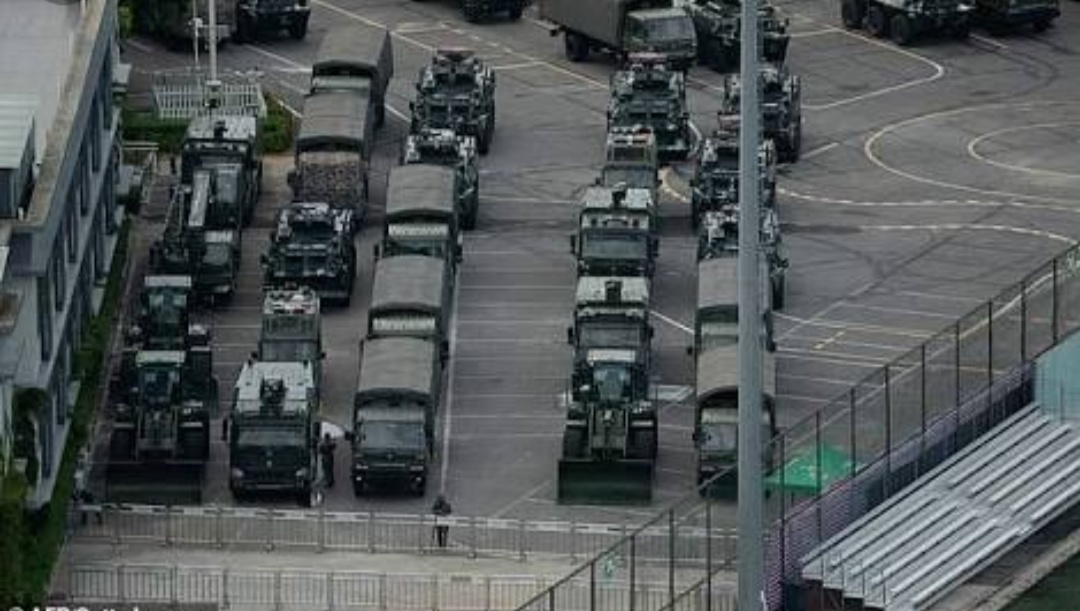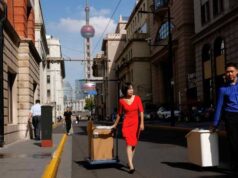Will PLA’S Paramilitary Cousin People Armed Police Be Able To Stabilize Hong Kong

As Hong Kong’s summer of discontent wears on, all eyes are on Beijing’s moves. A state council spokesman even WARNED that the protests were showing “signs of terrorism” and “must be resolutely combated according to law, with no hesitation or mercy.” Videos of Chinese troops parading and conducting anti riot drills across the border were shown in Shenzhen have also circulated online, Thus underscoring Beijing’s seriousness and raising the specter of a military intervention.
Many observers have stated that instead of the People’s Liberation Army (PLA) taking the lead, it is more likely that China would deploy the People’s Armed Police. This Force the PAP focuses on social stability missions.
Escalation to a 1989 Tiananmen Square-like crackdown is unlikely, but Beijing will still have to carefully weigh the risks of international condemnation or an inadvertent use of force by the People’s Armed Police. Those risks create a high bar for an intervention, even if it is led by paramilitary troops.
The Chinese Communist Party has maintained a paramilitary outfit since the 1920s, but the modern People’s Armed Police took shape under Deng Xiaoping in the early 1980s. In its early years, the force was in a poor state of readiness and modernization. When the Tiananmen crisis erupted in 1989, it was incapable of responding and active PLA troops had to be deployed.
Deng transferred PLA “economic construction” and law enforcement units such as gold miners and border guards to the People’s Armed Police in the 1980s, while 14 PLA divisions entered the People’s Armed Police ranks a decade later to become mobile contingency units. These transfers contributed to the modernization and streamlining of the PLA.
The experience of Tiananmen and the rise of local protests across China in the 1990s and 2000s, however, put pressure on the Chinese Communist Party to field a more capable force. This requirement came up tragically by the March 2008 when protests in Lhasa, Tibet led to rioting.
Over a two-week period, local police and People’s Armed Police units lost control of the situation, restored order through the use of deadly force, and had to be augmented by PLA troops for transportation and other support. The experience in Lhasa indicated that additional changes were necessary, but they were slow in coming.
On Jan. 1, 2018, as part of a major restructuring of the Chinese armed forces carried out under Xi Jinping, the People’s Armed Police was placed under the sole command of the Central Military Commission.
Previously, the People’s Armed Police had been under a “dual leadership” system in which it reported both to the commission and to the state council’s Ministry of Public Security.
The force itself also underwent significant structural reform. Most visibly, the China Coast Guardwas assigned to the People’s Armed Police, and its former economic production and law enforcement units were transferred to civilian ministries or local governments.
The force’s mobile capabilities, which can be deployed to areas beyond where they are stationed, have proliferated. Mobile rapid-response units are found in all the provinces and major cities. For example, Beijing has four, while Xinjiang has five.
These units are part of larger Internal Security Force “contingents” roughly the size of a small army corps. While most provinces only have one contingent, Xinjiang has two as well as a newly formed counter-terrorist unit, the Mountain Eagle Commandos, which reflects the fears of Uighur unrest in China’s far west.
Furthermore, in 2018, two large “mobile contingents,” one based in multiple provinces in northern China and one based in the south, were created, replacing the 14 former PLA divisions. These “mobile contingents” also command counter-terrorist, helicopter, and transportation/engineering units.
The increasing mobile capabilities of the People’s Armed Police have been buoyed by more advanced weapons and equipment, such as Z-11WB multi-role light utility helicopters, armored personnel carriers, assault rifles, sniper rifles, and special operations detachments.
They are also supported by a budget that has grown every year. After recent reforms, the force’s total strength is unknown but may be somewhere around 1 million — half of the size of the PLA.
The core mission of the People’s Armed Police centers on domestic stability (another mission is assisting the PLA by maintaining order and guarding key facilities in wartime).
Internal security forces have been mobilized on numerous occasions since the 1990s, including in several widely reported incidents in Guangdong province, across the border from Hong Kong. For instance, in 2011 People’s Armed Police units were deployed to respond to a crisis in the village of Wukan, where residents had revolted against the local government due to rampant corruption.
(That crisis was resolved only after higher-level officials brokered a deal between the parties.) In addition to conflict-prone areas such as Xinjiang and Tibet, the People’s Armed Police also has a strong presence in and around Beijing, where they can respond to a threat to the capital.
Thus, while they would be operating in a new environment, People’s Armed Police units from Guangdong or other parts of the country may have the requisite training and skills to handle widespread civil disturbances in Hong Kong.
By contrast, the PLA is more externally focused. Despite the PLA’s role in the 1989 Tiananmen protests, growing People’s Armed Police capabilities have allowed the PLA to shift more of its attention to regional warfighting and deterrence missions.
This combat focus has influenced how PLA units are organized, trained, and equipped, with a strong focus on advanced weapons that have little applicability in domestic unrest situations, and combat-realistic training tied to specific scenarios such as an amphibious assault on Taiwan.
PLA ground forces do have some experience dealing with hostile crowds, especially in U.N. peacekeeping missions in places like Mali and South Sudan, but this expertise is more the exception than the rule.
To be sure, the PLA does maintain a Hong Kong garrison of roughly 6,000 to 10,000 soldiers that might also be mobilized to respond. Aside from its limited numbers, a downside is that sending in active duty troops could create a more provocative escalation than sending in the “law enforcement” personnel of the People’s Armed Police.
As Dean Cheng noted during protests in 2014, Beijing would be wary of images of “tanks…rolling through downtown Hong Kong,” and fearing a repeat of the Tiananmen crisis, would likely use “alternative means to quell civil disobedience.” The People’s Armed Police, which has specialized training and practical experience in non-lethal riot control, would be an ideal go-to force.
Use of the People’s Armed Police would thus operate in a similar way to China’s use of lightly-armed Coast Guard and maritime militia forces to enforce sovereignty claims — both are ways to control escalation.
Centralizing Command
Nevertheless, the People’s Armed Police’s mixed track record raises questions about whether deadly force can be averted in Hong Kong. While violence was avoided in cases like Wukan, in other cases units have been involved in deadly incidents, including the 2008 Tibet clash mentioned earlier.
Another case took place in December 2005, when local party officials called on the People’s Armed Police to deal with a riot in Shanwei (also located in Guangdong), resulting in the death of 20 civilian protesters. Such incidents have not only marred China’s international image, but have also raised questions about training and professionalism.
Concerns about the widespread use of force in Hong Kong by the People’s Armed Police, however, are overblown. When lethal force has been used in the past, it’s often been the result of overzealous local officials who lose sight of the big-picture implications of killing civilians. However, this is irrelevant to Hong Kong, since the special administrative region does not have resident People’s Armed Police units.
Any such units would have to be sent from the mainland and would likely be centrally managed from the force’s headquarters in Beijing, with Xi and other top elites paying close attention to the situation.
(Even in mainland China, Xi has recently restricted the ability of local governments to call on People’s Armed Police units, which reflects the need to more carefully manage incidents.)
Even in chaotic circumstances, it is likely that the People’s Armed Police would follow strict rules of engagement. Any intervention would be closely watched by Hong Kong and international media, and the use of lethal force in any case other than self-defense could result in widespread blame focused on Beijing.
This would seriously undermine China’s current narrative, putting the onus for the crisis on radical protesters. Yet another reason to avoid lethal force is that the crisis in Hong Kong, unlike what transpired in 1989, does not pose an existential threat to the regime.
Pro-democracy protests have not spread to the mainland, let alone to Beijing, although evidence that the crisis is expanding beyond Hong Kong could be a rationale for intervention.
Using the People’s Armed Police to clamp down on Hong Kong protesters would, however, incur some risks for Beijing. One is that depending on the circumstances, deploying the People’s Armed Police could be construed as a major escalation of tensions, even if the decision is justifiable as a law enforcement action.
The People’s Armed Police, after all, is a constituent part of China’s armed forces (alongside active and reserve PLA units and the militia), and its personnel use equipment and wear uniforms that can be hard to distinguish from their PLA counterparts.
Such a move would gain widespread attention and condemnation, and make the task of reincorporating Hong Kong into the mainland more complicated over the long term.
An intervention would also reduce whatever little support for reunification remains in Taiwan and could set the stage for Democratic Progressive Party leader Tsai Ing-wen to win re-election in January 2020.
Another risk is that, while an intervention would be tightly stage-managed by Beijing, there is no guarantee that deaths and serious injuries to protesters would be avoided.
Isolated incidents are most likely to occur when the men and women of the People’s Armed Police feel cornered and fear for their own safety. It is worth noting that even the highly trained Hong Kong Police have drawn guns in recent days.
Even a single incident could overshadow evidence of professionalism and restraint by the People’s Armed Police. With these risks in mind, a Chinese intervention would probably be the last resort after all other options — relying on local authorities, waging public and clandestine media campaigns from Beijing, and saber-rattling from across the border — have been exhausted.




